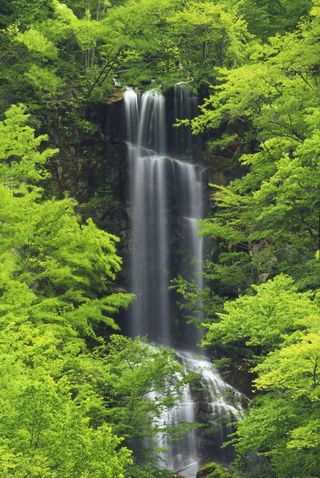How to Salvage Photos Gone Horribly Wrong
Not everybody has time to learn photography 101. Here’s how to make the best of bad images after the damage has been done, with software.
Hue Adjustment for Color Correction
The Hue Slider in the Hue/Saturation/Lightness control is another powerful tool for correcting color. One of the many interesting things about the Hue Slider is that it only affects the color portions of an image. The parts of your photo that contain black, white, and gray will be completely unaffected by the Hue Slider, making it ideal for adjusting certain images.
In the image below, the trees aren’t in the best of shape, as many of them show yellow leaves. Regardless of whether this problem really comes from unhealthy foliage or your camera not picking up the colors correctly, the yellow leaves are easy to fix with the Hue Slider.

An adjustment to the Hue Slider changes the yellow leaves to the green hue that you’d expect to see.

Since the Hue Slider only affects color, it didn’t make any changes to the grayscale waterfall in the background, making the Hue Slider the perfect color-correction tool for this photo.

In both the before and after photos, the leaves looked a bit blurred. Often, adjusting contrast can resolve blur issues, but in this case, contrast didn’t help enough, so the Sharpen tool was needed. Adding a mild amount of sharpening makes it easier to see the individual leaves.

Sign up to get the BEST of Tom's Guide direct to your inbox.
Get instant access to breaking news, the hottest reviews, great deals and helpful tips.
Current page: Hue Adjustment for Color Correction
Prev Page Saturation for Dull Images Next Page Keeping the Ocean Blue with Color Thumbnails-
superhighperf how about fixing the photo that was in the cover?Reply
http://media.bestofmicro.com/adjustment-saturation-tuning,0-4-178852-2.jpg
bait and switch article ?!?!?!?! -
As a professional VFX artist, I have to say that this article is a little on the juvenile side. Some of the "after" photos contain less information than the "before" photos. You never want to clip information in your photograph, and always want even exposure. Never underestimate a good matte for affecting only certain portions of your image. Furthermore, a good levels adjustment never hurt, and can always add some "punch" to your image.Reply
-
The article text provides a reasonable introduction to basic photo editing, but the "fixed" photos are perfect examples of what happens when a beginner goes way, way overboard. It's too bad because the miserable "after" photos significantly undermine the credibility of the article.Reply
-
mediv42 Why do people insist a bluer sky or greener trees make a better picture? Isn't the point of photography to capture what actually is, not whimsically change it to what you want it to be? Sure I understand if you underexposed the photo, or your white balance is off or whatever, but shouldn't the goal generally be what the subject actually looked like?Reply -
idisarmu This reminds me of the millions upon millions of teenage girls who see a picture of themselves and say, "Oh noes!!! ACNE!" *cries for hours and then suddenly has epiphany* "WAIT! I've GOT IT! I'll just crank up the brightness and make the picture black&white! THANK YOU COMPUTER!"Reply -
AARRGGHHH idisarmuThis reminds me of the millions upon millions of teenage girls who see a picture of themselves and say, "Oh noes!!! ACNE!" *cries for hours and then suddenly has epiphany* "WAIT! I've GOT IT! I'll just crank up the brightness and make the picture black&white! THANK YOU COMPUTER!"Reply
Black and White hides zits? That IS an epiphany.
I enjoyed the article.
